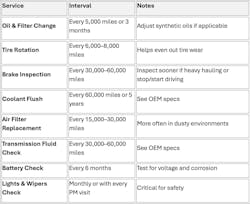As a plumbing contractor business owner, you know that your fleet is one of your business’s most valuable assets. Work trucks are one of the largest and most expensive investments tied to mechanical and plumbing contractor companies, so proper maintenance and upkeep are a must to keep your vehicles in top condition.
Creating a structured vehicle maintenance checklist is the first step, if you have not done so. Once you have your checklist, you can then decide if you want to create a spreadsheet to track maintenance or utilize fleet management/maintenance software. You may want to use software if you have more than a few vehicles in your fleet.
How to Create a Maintenance Checklist
Truck manufacturers have detailed maintenance schedules in their user manuals and service guides for you to follow. Plus, NAFA Fleet Management Association offers best practices for maintaining a maintenance schedule. When reviewing these sources, there are some key items that need to be included in a maintenance checklist. Below are the following items, plus, steps you can take to create a checklist:
1. Gather Vehicle Information: Create a master list of all your vehicles, including make, model and year; VIN; mileage; engine type; purchase date; and current condition.
2. Review Manufacturer Recommendations: Each manufacturer provides a recommended maintenance schedule. Collect these for each vehicle in your fleet, noting oil change intervals, transmission service, brake inspection, etc.
3. Determine Usage Patterns: Track mileage per vehicle per month, determine duty cycle, such as local customer service stops, delivery, stop-and-go. This helps create service intervals for each of your vehicles—every 5,000 miles or 3 months.
4. Define Maintenance Categories: Split your schedule into the following categories:
- Preventive Maintenance: Regular checks
- Corrective Maintenance: Repairs based on issues found
- Predictive Maintenance: This can be done if you are using telematics or sensor data.
5. Build a Maintenance Calendar: Each truck needs a maintenance schedule based on its odometer, age and OEM recommendations. You can create service intervals schedules, like this example for preventative maintenance:
6. Create a digital tracker or use fleet management/maintenance software: Once you have a checklist and calendar, use an online spreadsheet or fleet management/maintenance software to set automated reminders, track past service, monitor costs and downtime, and assign tasks to mechanics or vendors.
7. Monitor and Adjust: Track actual wear and failures to adjust the service schedule over time. Remember that the service schedule evolves, depending on what needs to be done to the vehicle.
Benefits of Fleet Management Software
It is possible for you or your fleet manager to oversee vehicle maintenance—but as your fleet grows, it becomes increasingly time-consuming. Depending on the size of your fleet—the more vehicles you have the more to track and maintain—it may be wise to use fleet maintenance/management software.
There are advantages to using fleet maintenance software. Ultimately it is a tool that will help save time, predict and prevent maintenance needs, and extend vehicles’ lifespans.
The following companies offer software ranging from customer relationship management to full-service maintenance management.
· Fleetio lets you monitor vehicle performance, manage parts inventory and stay on top of every maintenance task with automated service programs, issue-triggered workflows, and detailed reporting with easy collaboration across your team.
· ServiceTitan is primarily a customer relationship management platform with fleet management capabilities. Its features can be used to manage aspects of fleet operations, such as tracking vehicle maintenance, routing, and scheduling.
· Geotab offers fleet maintenance software with remote diagnostics, maintenance scheduling, and predictive maintenance tools. It notifies you of issues early on to prevent costly repairs.
· Simply Fleet offers you an easy-to-use fleet and equipment management software to enhance your fleet operations. It simplifies preventive maintenance, vehicle inspections, fuel management, and work order tracking.
When picking software to manage your fleet management/maintenance do thorough research to see what software fits your company’s needs best. Most companies let you schedule a demo to experience the features and benefits of their software.
Want to Learn More?
There are many aspects to managing fleet maintenance. To help you navigate this topic, here are a few resources about best practices, preventative care, and effective scheduling strategies.
- Fleet Maintenance Basics for First-Time Users by Summit Fleet: If you are new to fleet management this resource is perfect for you. It is tailored for those new to fleet management, offering advice on routine maintenance schedules, preventive care, and the role of fleet management services in supporting effective fleet maintenance.
- What Is Fleet Management? A Complete Guide for Fleet Managers Learn about the fleet management and maintenance process and how implementing a fleet management system can help you streamline operations when managing both gas powered and electric vehicles.
- 7 Fleet Management Best Practices: If you have a small, medium or large fleet, learn the best practices that can be applied to all fleet sizes and maintenance programs. Explore the strategies that promise smoother operations and cost savings.
Candace Roulo has more than 15 years of industry experience in the media and construction industries. She covers a variety of mechanical contracting topics, from sustainable construction practices and policy issues affecting contractors to continuing education for industry professionals and the best business practices that contractors can implement to run successful businesses.
About the Author
Candace Roulo
Candace Roulo, senior editor of CONTRACTOR and graduate of Michigan State University’s College of Communication Arts & Sciences, has 15 years of industry experience in the media and construction industries. She covers a variety of mechanical contracting topics, from sustainable construction practices and policy issues affecting contractors to continuing education for industry professionals and the best business practices that contractors can implement to run successful businesses.

